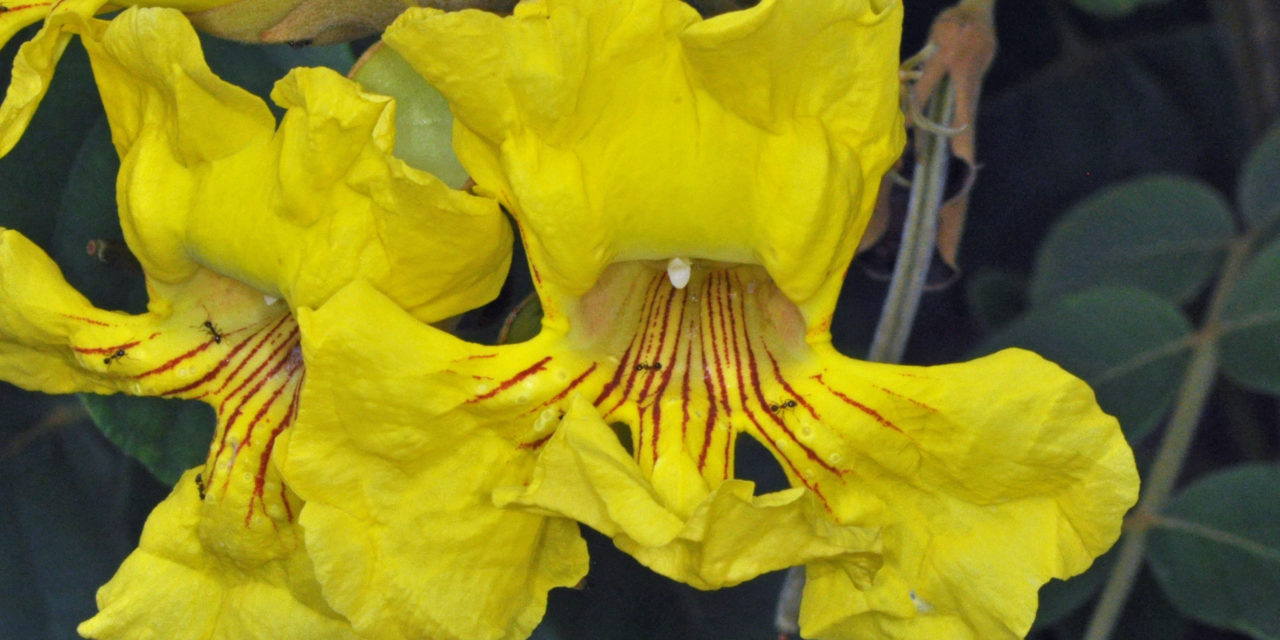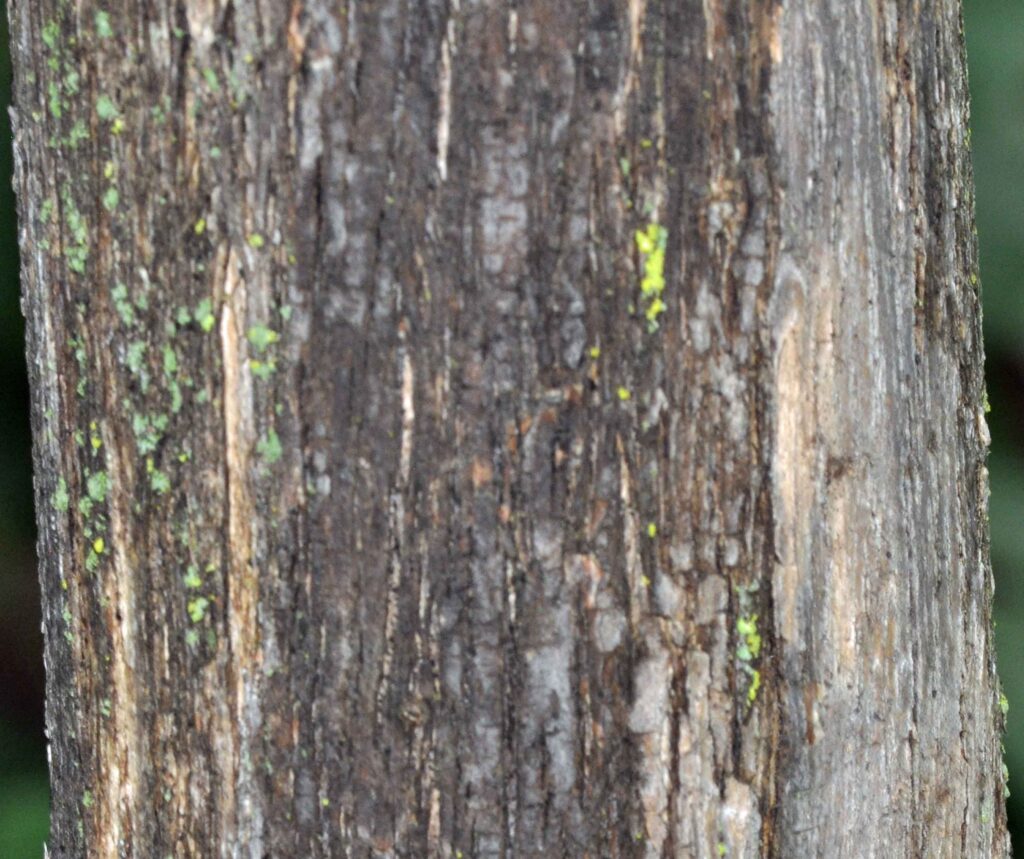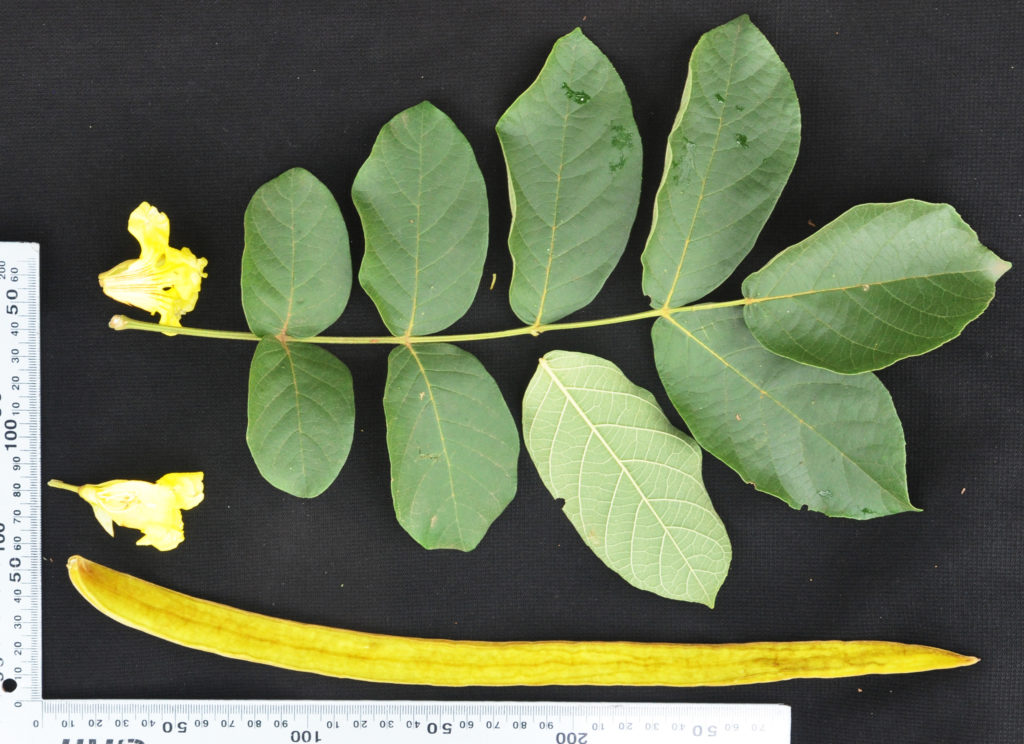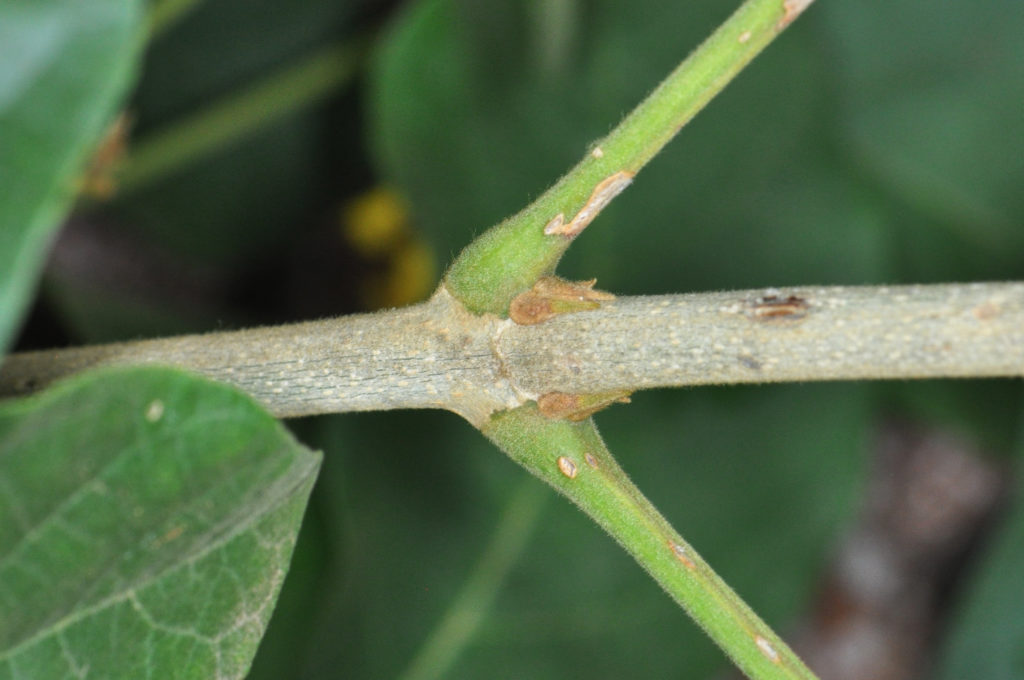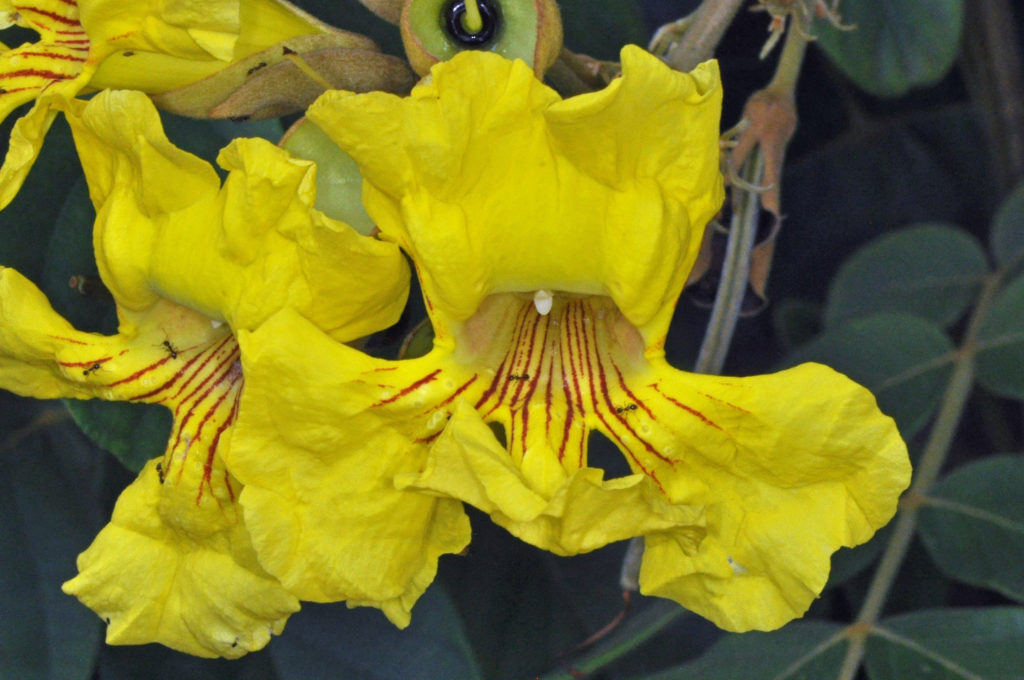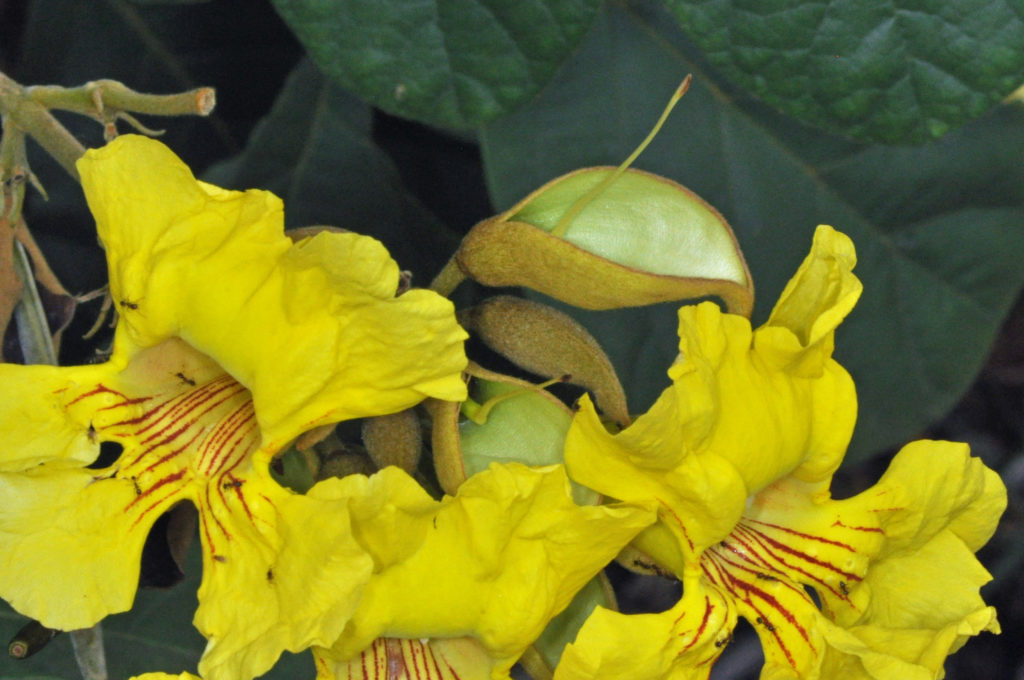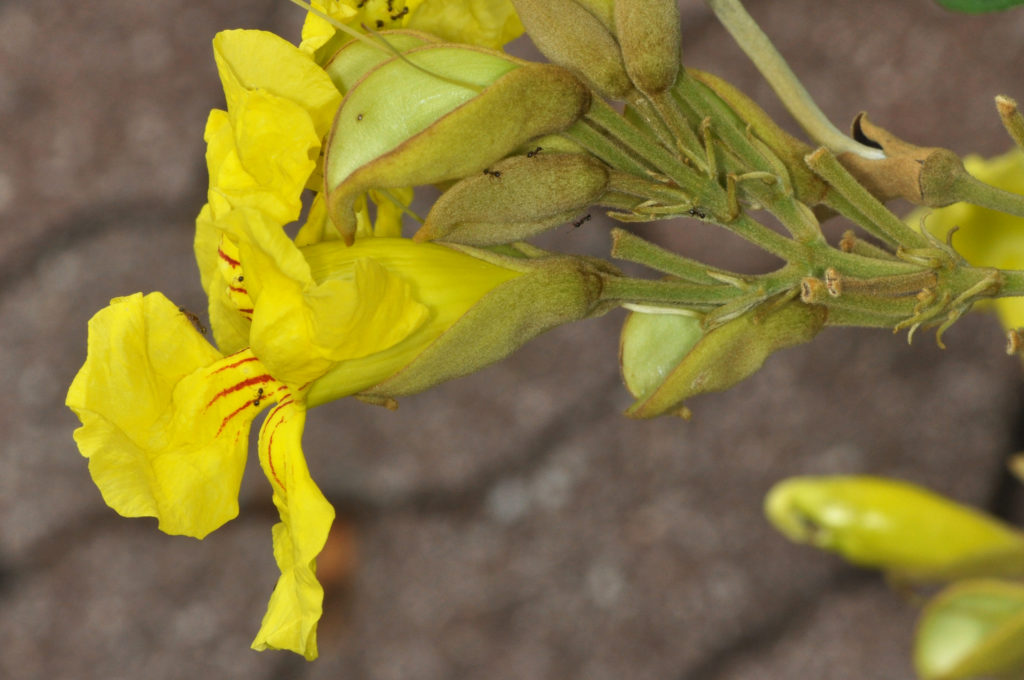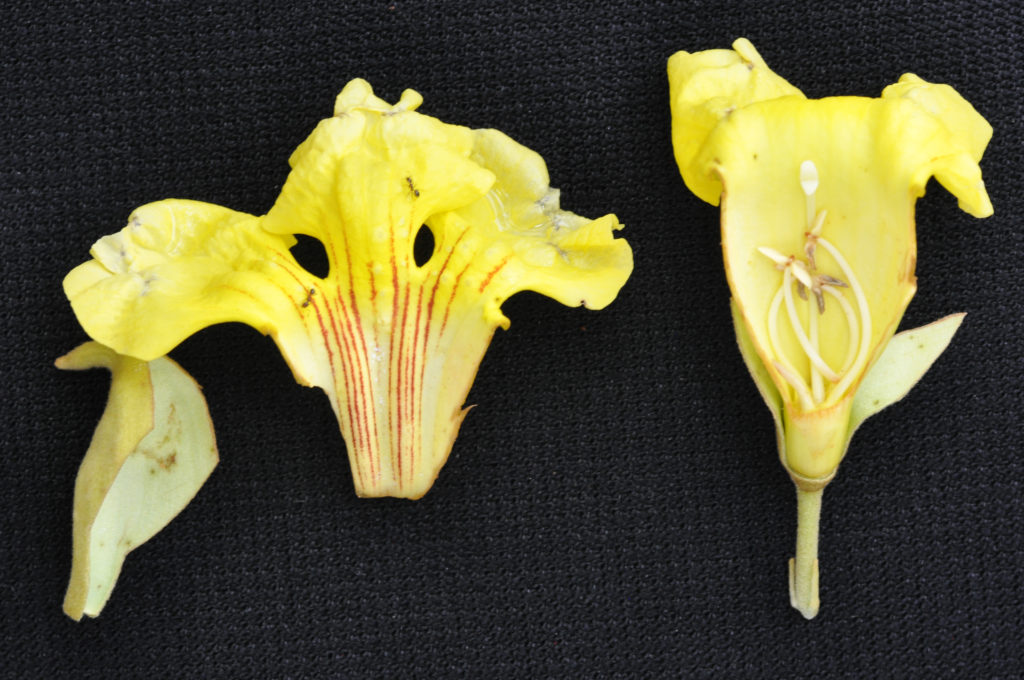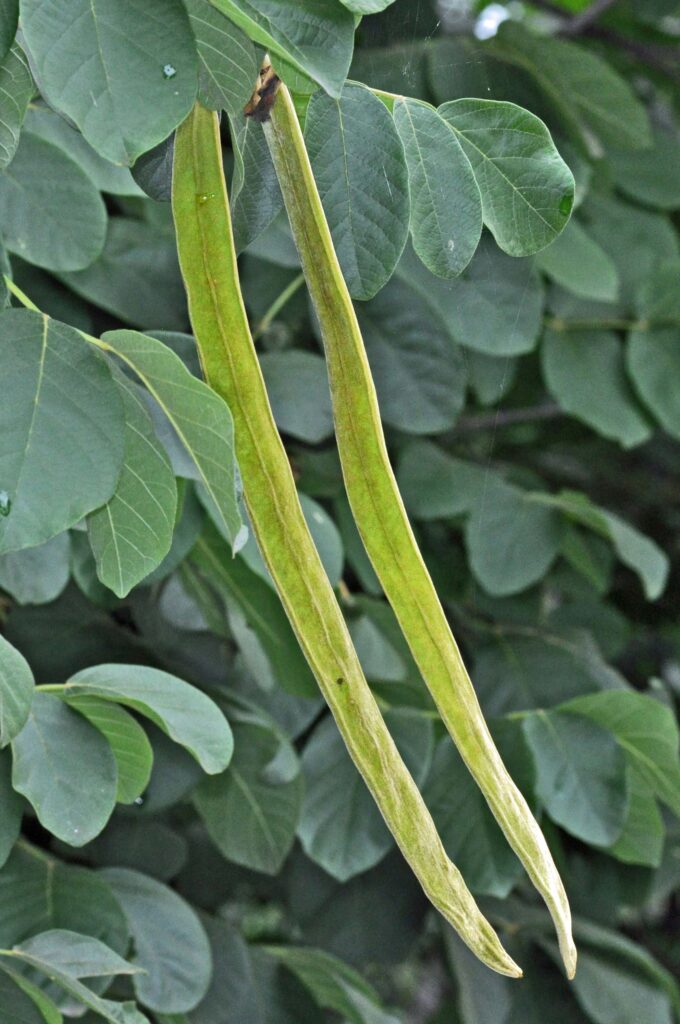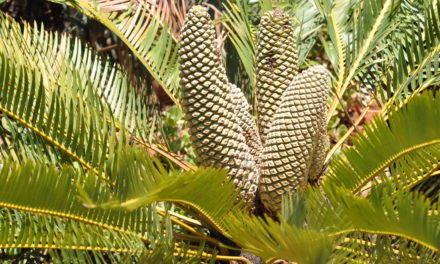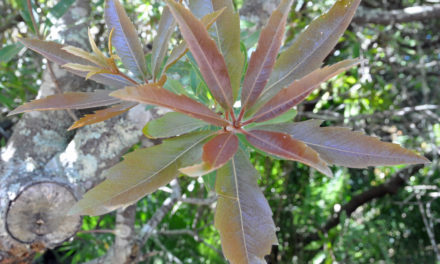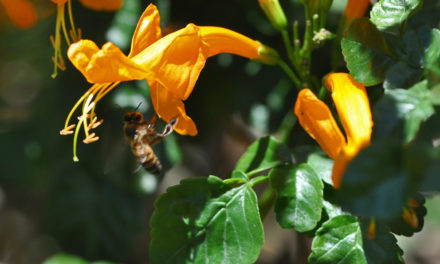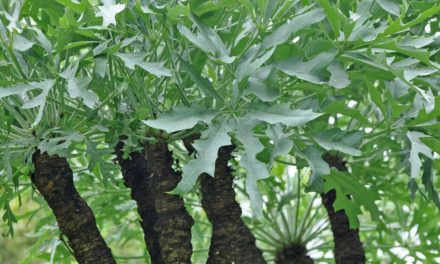General Info – summary
This Tree may reach 15m high. The initially light brown to grey bark develops longitudinal striations. Large opposite Leaves are imparipinnate and mature leaflets have entire margins. The spectacular large yellow bisexual 5-merous Flowers are in panicles. Stamens are didynamous. Neither the stamens nor the stigma extends beyond the petal lobes. The Fruit is a very long, pod-like capsule holding papery winged seeds.
Description
Markhamia obtusifolia
Previous Names: Dolichandra obtusifolia, Dolichandrone obtusifolia, Markhamia paucifoliolata, Markhamia verdickii, Markhamia lanata.
SA Tree No. 677.1
Common names: (Afr) Goueklokkiesboontjie, Goueklokkiesboontjieboom. (Eng) Golden Bean Tree, Golden Bell-bean.
Family: Bignoniaceae (Jacaranda family). There are about 104 genera and 810+ species. In South Africa, there are 6 genera + 2 naturalised with a total of 13 species. The indigenous genera with trees on this website include Bignonia, Kigelia, Markhamia, Rhigozum, and Tecomaria. Most species are woody. Leaves are usually compound, opposite and lack stipules. The usually large and brightly coloured Flowers are bisexual and irregular. They usually occur in panicles or racemes or are solitary. The Calyx has 5 partly united sepals which are shorter than the usually 5 joined Petals producing a conspicuous tube. The petals are often 2-lipped with the upper lip having 3 lobes and the lower lip with 2 lobes. There are usually 4 didynamous Stamens (2 long and 2 short) which arise from the corolla tube. A single staminode may be present. The Anthers have 2 pollen sacs which dehisce longitudinally. There is a superior Ovary with 2 united carpels. Many ovules are present. The simple Style terminates in a Stigma with 2 flattened lobes. The Fruit is usually a bivalved capsule. Seeds are usually flat and usually have a glassy, translucent wing.
Name derivation: Markhamia named by Berthold Seeman, in honour of Sir Clements Robert Markham (1830-1916), an English geographer and traveller, who introduced a famous quinine-yielding tree Cinchona pubescens (family Rubiaceae) into India. obtusifolia – presumably referring to the obtuse leaflet base. There are 2 species of the genus Markhamia in southern Africa. The other is M. zanzibarica.
Conservation: National Status: L C. (Least Concern). Assessment: 2005 (W. Foden and L. Potter).
Tree
This 1-2m high shrub, may also be an upright small bushy Tree that is usually up to 8m, but may reach 15m in height. Young branches are minutely lepidote (surfaced with small scruffy scales) and Lenticels (a usually raised corky oval or elongated area on the plant that allows the uncontrolled interchange of gases with the environment) are present on young stems (photo 735 – under Leaves). The young growth covered with long thick golden hairs. Bark is light brown to grey becoming rough and developing thin longitudinal striations in older trees (photo 747).
- 747 2017.01.31 Pretoria NBG. Photo: David Becking. Pretoria NBG
Leaves
The Leaves are opposite (photo 735) and imparipinnate (pinnately compound leaf ending in a single leaflet – photo 745). The initially golden hairy leaves soon lose hair especially from the upper surface. The paired leaflets increase in size towards the leaf apex. The 3-5 pairs of opposite leaflets are large – up to 24 x 19cm (photo 745). Each leaflet is oblong to elliptic, and leaflets increases in size towards the single Terminal leaflet. The single terminal leaflet is shorter than the adjacent pair (photo 745). Leaflets have dense golden hairs when young but less on the upper surface when mature. The surface has small, scruffy scales. Midrib and lateral veins are sunken above and protrude below (photo 745). The Apex is rounded, notched or attenuate (showing a long gradual taper of base or apex) or very shortly acuminate (said of an acute apex whose sides are somewhat concave and taper to a protracted point). The Base may be asymmetric (photo 745), and is square, rounded or obtuse. The Margins of mature leaflets are entire (with a continuous margin, not in any way indented). Margins are wavy and young leaflets may be toothed. The Petiole (leaf stalk) is 2-9cm long and swollen at the base (photo 735) and Petiolules (leaflet stalks) are usually absent. The midrib and petiole are ribbed above. Stipules (basal appendage of the petiole) are absent. Impressive roughly ovate Pseudostipules (false stipules are often a modified pair of leaflets that appear very close to the stem in a compound leaf – Photo: 735) are present – unusual.
- 745 2017.01.31 Pretoria NBG. Photo: David Becking.
- 735 2017.01.31 Pretoria NBG. Photo: David Becking.
Flowers
The bright yellow and impressive Flowers develop at the ends of shoots in terminal Panicles (indeterminate, branched inflorescence with stalked flowers). The mature inflorescence is up to 20cm long. Dense golden hairs cover the buds. A Pedicel (stalk of each single flower– photo 737) is present and is about 12mm long. Each flowers is bisexual and zygomorphic (floral parts are unequal in size or form so that the flower is capable of division into essentially symmetrical halves by only one longitudinal plane passing through the axis). The leathery green, golden and hairy Calyx is boat shaped and gamosepalous (a calyx whose sepals are at least partly united). It is much shorter than the corolla tube and split down the one side (Photo 736). The Corolla tube is up to 4,5cm long and is gamopetalous (with united joined petals – at least at the base). As a result, the corolla is removable as a single piece. The corolla is 2-lipped and has 5 crinkled lobes – 2 on the upper lip and 3 on the lower lip. On the lower lip, the centre lobe eventually splits into 2 parts. The start of the splitting is visible in photo 732. The most impressive reddish streaks occur in the centre of the 3 lower lobes – less in the two outer adjacent lobes (photo 732). These lobes spread and may reach 6cm in diameter. Stamens are didynamous (having 4 stamens disposed in 2 pairs of 2 different lengths). Like many plants in the family Bignoniaceae, a single staminode (sterile stamen) is also present. The stamens alternate with the corolla lobes. The Anthers have 2 thecae (pollen sacs) that are cone shaped above, divergent below (photo 746) and attached to the Filament at the apex. Stamens do not protrude beyond the corolla tube. The oblong, superior Ovary has 2 locules with many ovules. The Style is circular in cross section and remains within the corolla tube and ends slightly beyond the stamens. The Stigma has 2 white lobes (photo 746). (Nov-Jun).
- 732M 2017.01.31 Pretoria NBG. Photo: David Becking.
- 736 2017.01.31 Pretoria NBG. Photo: David Becking.
- 737 2017.01.31 Pretoria NBG. Photo: David Becking.
- 746 2017.01.31 Pretoria NBG. Photo: David Becking.
Fruit
The very long, obovate, more or less straight or slightly sickle-shaped, slender flattened and pendulous, pod-like Fruit is a slender Capsule (a dry fruit resulting from the maturing of a compound ovary that usually opens at maturity by one or more lines of dehiscence). This narrow capsule is up to 85 x 2,5cm – usually shorter (photo 733 & 745 – under Leaves). Mature capsules have dense golden hairs. Two flattened valves are present that dehisce parallel to a false septum (a partition or wall between 2 tissues or cavities). Mature fruit has raised lenticels (usually raised corky elongated areas on the plant that allows the uncontrolled interchange of gases with the environment). A visible longitudinal ridge runs between the 2 flattened sides and marks the line of dehiscence (photo 733). Both the Seeds up to 4 x 1,2cm, and the 2 papery seed wings are almost rectangular. The Testa (seed covering) is slightly leathery. (Jan-Sep).
- 733 2017.01.31 Pretoria NBG. Photo: David Becking.
Distribution & Ecology
These plants develop at medium to low altitude in woodlands and evergreen mountain forest margins. They may occur on rocky hills, Kalahari Sands, and on hill slopes from close to sea level (usually slightly above) to 2 000m. These Plants are located in Limpopo and Mpumalanga – e.g., northern Kruger. They also occur in central and northern Mozambique, Botswana, Zimbabwe and Namibia – Caprivi Strip. Further north, they occur in Tanzania, Malawi, the DRC and Kenya. Young growth has long, golden hairs. Ants may be involved in pollination.
Ethnobotany
The Wood is used for building and making tool handles. It is hard, strong, fine grained and produces a smooth finish and is useful for carving. Propagation is by truncheons (stem cutting from a selected plant – used to produce genetically identically new plants) and Seeds. The latter germinate easily. Traditional medicine makes use of parts of this plant – including the Roots.
References
Burrows, J.E., Burrows, S.M., Lotter, M.C. & Schmidt, E. 2018. Trees and Shrubs Mozambique. Publishing Print Matters (Pty) Ltd. Noordhoek, Cape Town.
Coates Palgrave, M. 2002. Keith Coates Palgrave Trees of Southern Africa, edn 3. Struik, Cape Town.
Foden, W. & Potter, L. 2005. Markhamia obtusifolia (Baker) Sprague. National Assessment: Red List of South African Plants version 2020.1. Accessed on 2023/09/06.
Lawrence, G. H. M, 1951. Taxonomy of Vascular Plants. The Macmillan Company, New York. Tenth Printing 1965.
Palmer, E. & Pitman, N. 1972. Trees of southern Africa. Balkema. Amsterdam, Cape Town.
Schmidt, S. Lotter, M. & McCleland, W. 2002. Trees and Shrubs of Mpumalanga and the Kruger National Park. Jacana, Johannesburg.
Ntuthuko Mabuya Horticulturist: Conservation garden and Tourism. South African National Biodiversity Institute (SANBI). Pretoria National Botanical Garden: for help with the ID.
http://www.plantzafrica.com/plantklm/markhamzan2.htm
http://posa.sanbi.org/flora/browse.php?src=SP
http://www.zimbabweflora.co.zw/speciesdata/species.php?species_id=152410
https://en.wikipedia.org/wiki/Cinchona
Markhamia obtusifolia in Global Plants on JSTOR

